Spatiotemporal Differentiation Characteristics and Zoning of Cultivated Land System Resilience in the Songnen Plain
Abstract
1. Introduction
2. The Evolution and Functional Mechanisms of Cultivated Land System Resilience
2.1. The Evolution of Cultivated Land System Resilience
2.2. The Connotation and Mechanisms of Cultivated Land System Resilience
3. Materials and Methods
3.1. Overview of the Study Area
3.2. Data Sources
3.3. Research Methods
3.3.1. Development of the Cultivated Land System Resilience Evaluation Framework
3.3.2. Improved Entropy Weight Method
3.3.3. Three-Dimensional Euclidean Distance
3.3.4. Kernel Density Estimation
3.3.5. K-Means Clustering
4. Results
4.1. Spatiotemporal Differentiation Characteristics of Overall Cultivated Land System Resilience in the Study Area
4.2. Spatiotemporal Differentiation of Cultivated Land System Resilience at the County Level
4.3. Analysis of Zoning Results for Cultivated Land System Resilience
- (1)
- Core Advantage Zone. This zone exhibits the highest resilience level, primarily ecompassing Wuchang City and Nenjiang City, accounting for a relatively small proportion of the total area. It has advantageous natural resources, well-developed agricultural infrastructure, and advanced modern agricultural technologies, resulting in outstanding agricultural productivity and ecosystem stability. Wuchang City is renowned for its high-quality rice production, supported by abundant water resources, fertile black soil, and advanced agricultural mechanization and technological innovation. Nenjiang City similarly features high agricultural mechanization, high productivity, strong ecosystem recovery capacity, and diversified economic structures that ensure regional economic stability. Due to their strong resource management and adaptability to external changes, these areas serve as core demonstration regions for agricultural and resource management in the Songnen Plain. Policies should therefore consolidate their leading roles in modern agriculture, resource management, and ecological protection.
- (2)
- Stable Maintenance Zone. This zone is located in the central and northern regions of the Songnen Plain, comprising 23 counties and accounting for 36.51% of the study area. Agricultural production here remains relatively stable, characterized by limited changes in cultivated land area, moderate levels of agricultural mechanization, and medium values of cropping intensity and net primary productivity. Ecosystems in this zone recover gradually after disturbances but less efficiently than those in the core advantage zone. The stable maintenance zone demonstrates moderate adaptability and resistance but has limited resilience against extreme climate events or economic fluctuations. The primary sector dominates local economies, and while rural populations are sufficient, low skill levels and insufficient agricultural innovation limit agricultural productivity improvements. Counties such as Hulan District and Yi’an County exemplify this zone, having solid agricultural foundations but significant potential for enhancing mechanization and agricultural modernization. Policy recommendations include improving agricultural technology, optimizing resource management, and promoting economic diversification to strengthen regional adaptability and stability.
- (3)
- Transition Adjustment Zone. Primarily distributed in the northeastern fringe and southern areas of the Songnen Plain, this zone includes 20 counties, covering 30.16% of the study area. Agricultural practices remain traditional, with low mechanization, low cropping intensity, and limited ecosystem recovery capacity. Production efficiency is significantly constrained by natural conditions. This region suffers from moderate vegetation cover, fragmented landscapes, weak soil and water conservation, and high vulnerability to climate change and extreme weather events. The rural economy depends heavily on agriculture with a single-industry structure, lacking technological support and innovation. Typical counties include Wudalianchi City and Jiaohe City, characterized by low agricultural productivity, fragile ecosystems, and outdated water and soil management practices. Enhancing productivity and ecological stability in this zone thus requires strengthening water and soil resource management, developing irrigation infrastructure, and introducing modern agricultural technologies to enhance ecosystem restoration capacity.
- (4)
- Vulnerable Risk Zone. This zone is located in the central–western areas of the Songnen Plain, comprising 18 counties and accounting for 28.57% of the study area. It exhibits low agricultural productivity and weak ecosystem resilience, with significantly lower cropping intensity and production efficiency. Agricultural production is highly dependent on natural conditions, yet the region demonstrates limited resilience against extreme weather events. Declining soil fertility, severe soil erosion, and weak ecosystem recovery capacity exacerbate vulnerability. The rural economy is simplistic, with limited economic activities beyond agriculture, and suffers from severe labor migration and aging populations, further constraining agricultural productivity. Counties like Mingshui County and areas surrounding Harbin illustrate traditional agricultural practices with low mechanization and limited technology adoption, facing ecosystem degradation pressures. Priority policy support is necessary, particularly through ecological restoration, infrastructure development, and agricultural technology dissemination, enhancing the adaptability and stability of agricultural systems.
5. Discussion
5.1. Spatiotemporal Differentiation and Zoning of Cultivated Land System Resilience
5.2. Innovations
5.3. Policy Recommendations
- (1)
- Enhance agricultural technology, and establish a robust disaster early warning system. Given the temperate continental monsoon climate of the Songnen Plain, characterized by warm, humid summers and cold, dry winters, it is essential to select and breed crop varieties that are drought-tolerant, cold-resistant, and pest-resistant, all suited to local climatic conditions and geared toward improving crop resilience. Additionally, adopting precision agriculture technologies—such as drone-based remote sensing, smart irrigation systems, and precise fertilization methods—can further strengthen agricultural resilience. This study found that natural factors, including precipitation and sunlight duration, influence farmland system resilience, so improving disaster early warning systems and enhancing meteorological monitoring to issue timely warnings will therefore help farmers prepare better and mitigate potential income losses from natural disasters. Furthermore, providing subsidized agricultural insurance can encourage greater participation from farmers. In core advantage regions of the southern and central areas (e.g., Wuchang City and Shuangcheng District), government-funded smart agriculture initiatives can introduce technologies like drone monitoring, soil sensors, and precision irrigation for more targeted management. For example, installing soil moisture sensors can enable real-time monitoring for precise irrigation and fertilization. As these technologies evolve, their expansion into areas with moderate adaptability can serve as a model to enhance production efficiency and resource conservation.
- (2)
- Strengthen land management and protection; complement ecological conservation and restoration. Preventing the conversion of farmland into non-agricultural or non-grain uses is crucial. Strict enforcement of farmland protection policies can curb illegal occupation and excessive development, thereby stabilizing farmland areas. Equally important is preserving the natural environment of the Songnen Plain to maintain ecological balance and prevent over-exploitation or ecological degradation. As a major production base for crops such as corn, soybeans, and rice, the black soil region of the Songnen Plain has increasingly been prioritized by China’s farmland protection initiatives in recent years. With programs such as high-standard farmland construction, land consolidation, and ecological restoration, the resilience of farmland systems has improved. As China transitions to high-quality development, refining farmland management mechanisms becomes even more critical. Ensuring no net reduction in farmland area, guaranteeing quality and quantity, optimizing land use structures, and enhancing land use efficiency are all necessary measures. These actions will not only promote economic development and sustainable agriculture but also protect ecosystems and reinforce the Songnen Plain’s role as a critical grain production base for China.
- (3)
- Adopt region-specific strategies based on zoning outcomes. Based on the zoning results, distinct strategies should be implemented for each zone according to its specific characteristics. In core advantage zones, focus should be placed on high-efficiency agriculture, the promotion of precision farming technologies, and green agricultural development, while establishing demonstration bases for the coordinated advancement of agriculture and ecology. In stable maintenance zones, optimizing crop structures, diversifying operational models, enhancing soil and water conservation, and improving soil quality through policy support and technology adoption can increase regional adaptability. In low-resilience zones, priorities should include soil improvement and ecological restoration projects, optimizing irrigation and drainage systems, developing climate-resilient specialty crops, and minimizing overdevelopment. In ecologically sensitive zones, strict ecological protection lines should be established, promoting ecological farming practices and intensifying efforts to restore wetlands and forests, ensuring the recovery and stability of regional ecosystems. Ultimately, these zoned management practices will support the sustainable use of farmland resources while promoting coordinated regional economic development.
5.4. Limitations and Outlook
5.4.1. Study Limitations
5.4.2. Outlook and Future Work
6. Conclusions
- (1)
- Overall Upward Trend in Resilience
- (2)
- Kernel Density Analysis
- (3)
- Zoning Results
Author Contributions
Funding
Institutional Review Board Statement
Informed Consent Statement
Data Availability Statement
Acknowledgments
Conflicts of Interest
References
- Lal, R. Soil carbon sequestration to mitigate climate change. Geoderma 2004, 123, 1–22. [Google Scholar] [CrossRef]
- Turner, B.L., 2nd; Lambin, E.F.; Reenberg, A. The emergence of land change science for global environmental change and sustainability. Proc. Natl. Acad. Sci. USA 2007, 104, 20666–20671. [Google Scholar] [CrossRef]
- Zhao, Z.; Lei, M.; Wen, L.; Xie, E.; Kong, X. Research status, development trends, and the prospects of cultivated land risk. Front. Environ. Sci. 2023, 11, 1175239. [Google Scholar] [CrossRef]
- Reid, W.V.; Mooney, H.A.; Cropper, A.; Capistrano, D.; Carpenter, S.R.; Chopra, K.; Dasgupta, P.; Dietz, T.; Duraiappah, A.K.; Hassan, R. Ecosystems and Human Well-Being-Synthesis: A Report of the Millennium Ecosystem Assessment; Island Press: Washington, DC, USA, 2005. [Google Scholar]
- Metzger, M.J.; Rounsevell, M.D.A.; Acosta-Michlik, L.; Leemans, R.; Schröter, D. The vulnerability of ecosystem services to land use change. Agric. Ecosyst. Environ. 2006, 114, 69–85. [Google Scholar] [CrossRef]
- Folke, C. Resilience: The emergence of a perspective for social–ecological systems analyses. Glob. Environ. Chang. 2006, 16, 253–267. [Google Scholar] [CrossRef]
- Carpenter, S.; Walker, B.; Anderies, J.M.; Abel, N. From Metaphor to Measurement: Resilience of What to What? Ecosystems 2014, 4, 765–781. [Google Scholar] [CrossRef]
- Walker, B.; Salt, D. Resilience Thinking: Sustaining Ecosystems and People in a Changing World; Island Press: Washington, DC, USA, 2012. [Google Scholar]
- Gallopín, G.C. Linkages between vulnerability, resilience, and adaptive capacity. Glob. Environ. Change 2006, 16, 293–303. [Google Scholar] [CrossRef]
- Xu, W.; Jin, X.; Liu, J.; Li, H.; Zhang, X.; Zhou, Y. Spatiotemporal evolution and the detection of key drivers in the resilience of cultivated land system in major grain-producing regions of China. Land Degrad. Dev. 2023, 34, 4712–4727. [Google Scholar] [CrossRef]
- Song, C.; Xiang, H.; Chen, M.; Du, H. Spatiotemporal differentiation of ecological vulnerability in the Songnen Plain from 1980 to 2020. Bull. Soil Water Conserv. 2023, 43, 366–374. [Google Scholar] [CrossRef]
- Wu, Y. Spatiotemporal Evolution Characteristics and Influencing Factors of Agricultural Regional Functions in the Songnen Plain. Master’s Thesis, Northeast Normal University, Changchun, China, 2022. [Google Scholar]
- Cimellaro, G.P.; Reinhorn, A.M.; Bruneau, M. Framework for analytical quantification of disaster resilience. Eng. Struct. 2010, 32, 3639–3649. [Google Scholar] [CrossRef]
- Alexander, D.E. Resilience and disaster risk reduction: An etymological journey. Nat. Hazards Earth Syst. Sci. 2013, 13, 2707–2716. [Google Scholar] [CrossRef]
- Holling, C.S. Resilience and stability of ecological systems. In International Institute for Applied Systems Analysis Laxenburg; Cambridge University Press: Cambridge, UK, 1973. [Google Scholar]
- Adger, W.N. Social and ecological resilience: Are they related? Prog. Hum. Geogr. 2000, 24, 347–364. [Google Scholar] [CrossRef]
- Folke, C.; Carpenter, S.R.; Walker, B.; Scheffer, M.; Chapin, T.; Rockström, J. Resilience thinking: Integrating resilience, adaptability and transformability. Ecol. Soc. 2010, 15, 4. Available online: https://www.jstor.org/stable/26268226 (accessed on 6 May 2025).
- Xie, H. Study on the impact of cultivated land quality improvement strategies on the yield of major grain crops. Seed Sci. Technol. 2025, 43, 207–209. [Google Scholar] [CrossRef]
- Chen, M.; Lv, J. Evaluation of cultivated land ecological security and obstacle factor diagnosis in the upper reaches of the Yellow River based on the entropy weight–TOPSIS method. J. Yunnan Agric. Univ. 2024, 18, 72–80. [Google Scholar] [CrossRef]
- Lee, C.-C.; Qian, A. Regional differences, dynamic evolution, and obstacle factors of cultivated land ecological security in China. Socio-Econ. Plan. Sci. 2024, 94, 101970. [Google Scholar] [CrossRef]
- Gong, P.; Ren, Y. Spatiotemporal evolution of cultivated land ecosystem resilience in Inner Mongolia from a social–ecological perspective. J. Arid. Land Resour. Environ. 2025, 39, 84–93. Available online: https://kns.cnki.net/kcms2/article/abstract?v=RNPVX-4KY7iW5GLMWRD10hjw16DGywnIVvkMU5efsH1BUUAQQIV1bN9Bcnw9CVU7TPhyy9ts9-e_0nbSryqSUvwgpEItzgigozX190TsEqNA_Ytflfo_vso6CdnxWqEOjuiHfir8E2cLaTIJUW6ChpCsN_Frbllax_8G6dweEWmx7RwGmesmo08SABGQcC9ZbMa-dxP20tY=&uniplatform=NZKPT (accessed on 6 May 2025).
- Chen, L.; Zhao, N.; Zhang, Z.; Zhang, Y.; Zuo, W.; Wang, Y.; Wu, B.; Stanny, M.; Li, Y.; Du, G. Population Shrinkage and Spatio-Temporal Changes in Cultivated Land Use Efficiency in China’s Agro-Pastoral Ecotone. Land 2025, 14, 63. [Google Scholar] [CrossRef]
- Zhang, H.; Zhu, C.; Jiao, T.; Luo, K.; Ma, X.; Wang, M. Analysis of the Trends and Driving Factors of Cultivated Land Utilization Efficiency in Henan Province from 2000 to 2020. Land 2024, 13, 2109. [Google Scholar] [CrossRef]
- Ma, M.; Guo, H.; Li, J.; Song, Y. Spatiotemporal evolution and interactive response of cultivated land multifunctionality and use efficiency: A case study of Guangdong Province. J. Shandong Inst. Agric. Eng. 2024, 41, 25–36. [Google Scholar] [CrossRef]
- Yin, Z. Spatiotemporal variation of land use patterns and their relationship with climatic factors in the Songnen Plain. Environ. Impact Assess. 2023, 45, 63–71. [Google Scholar] [CrossRef]
- Zhang, X.; Cen, Y.; Gao, Z.; Li, Y.; Sun, G.; Liu, W. Response of ecological environmental quality to climate and land use change on the Loess Plateau from 2001 to 2020. Bull. Soil Water Conserv. 2023, 43, 234–244. [Google Scholar] [CrossRef]
- Cai, B.; Xie, M.; Liu, Y.; Liu, Y.; Feng, Q. Availability-based engineering resilience metric and its corresponding evaluation methodology. Reliab. Eng. Syst. Saf. 2018, 172, 216–224. [Google Scholar] [CrossRef]
- Lei, S.; Zhao, W.; Lei, Y. Research on the improvement of engineering resilience in urban underground space. Tunn. Constr. 2023, 43, 1627–1636. Available online: https://kns.cnki.net/kcms2/article/abstract?v=RNPVX-4KY7hCUZdaZq3GjmQm2xOPaOVlqKcuLUp5gksAkHsaEPG4ARv7yUej0s-InrQ1LvcPwmePPE4_HB35m0hCn19_mC0J7eIqDbshKZcMkF_W0UqyZBGoC2zaOJMmhFuRlyacgqSwmStluuE4bht1-D2xqcAIPc74nBPAOq3TyElIYRuGy9-joT-JSY3KatJLfT_olc8=&uniplatform=NZKPT (accessed on 6 May 2025).
- Zhao, H.; Qu, X.; Feng, X.; Wu, K.; Huang, Q. Theoretical and empirical study on the elastic deformation of cultivated land. Areal Res. Dev. 2012, 31, 73–77. [Google Scholar]
- Lyu, X.; Wang, Y.; Niu, S.; Peng, W. Spatio-Temporal Pattern and Influence Mechanism of Cultivated Land System Resilience: Case from China. Land 2021, 11, 11. [Google Scholar] [CrossRef]
- Fang, Y.; Wang, Q.; Huang, Z.; Wu, Y. Spatiotemporal evolution and influencing mechanisms of tourism economic resilience in China. Prog. Geogr. 2023, 42, 417–427. Available online: https://kns.cnki.net/kcms2/article/abstract?v=RNPVX-4KY7hvvRmkT3Z3YM7NfdqGuwi-SvBkTKkiMPTa_pZ49gQkaaDraP1kTKqLnx85vUW5BiylMdtY1MwJ_UUyLKj6BtCiEC5kLKWa2ql9-V1kqyQsOEbqh_yRQNjsK5HfmroENLCtUQ7mn_qlfnvtqxSfpbU2jbhCM67YfR2ey5HD-m5bzPIWZrT7kbfvlJkXqA9OjTY=&uniplatform=NZKPT (accessed on 6 May 2025). [CrossRef]
- Paas, W.; San Martín, C.; Soriano, B.; van Ittersum, M.K.; Meuwissen, M.P.M.; Reidsma, P. Assessing future sustainability and resilience of farming systems with a participatory method: A case study on extensive sheep farming in Huesca, Spain. Ecol. Indic. 2021, 132, 108236. [Google Scholar] [CrossRef]
- Li, L.; Zhang, Y.; Fu, B.; Song, X.; Zhang, Y. Evaluation and spatial differentiation of cultivated land resilience in Kunming City. Sci. Technol. Eng. 2021, 21, 4848–4855. [Google Scholar]
- Zhang, Y.; Zhou, D.; Li, Z.; Qi, L. Spatial and temporal dynamics of social-ecological resilience in Nepal from 2000 to 2015. Phys. Chem. Earth Parts A/B/C 2020, 120, 102894. [Google Scholar] [CrossRef]
- Jiao, L.; Deng, J.; Wu, Y.; Huo, X. Evaluation of urban resilience level based on the PSR–cloud model. Ecol. Econ. 2022, 38, 114–120. [Google Scholar]
- Yin, X.; Li, Z.; Xu, G.; Wan, C. Integrating Resilience Theory into a Cultivated Land System: Empirical Insights from China’s Key Grain-Producing Regions. Land Degrad. Dev. 2024, 35, 5425–5438. [Google Scholar] [CrossRef]
- Miao, X.; Li, Z.; Wang, M.; Mei, J.; Chen, J. Measurement of cultivated land ecosystem resilience in black soil region of Northeast China under the background of cultivated land protection policy in China: Case study of Qiqihar City. J. Clean. Prod. 2024, 434, 140141. [Google Scholar] [CrossRef]
- Zhu, Q.; Cai, Y. Impacts of ecological risk and ecosystem health on ecosystem services. Acta Geogr. Sin. 2024, 79, 1303–1317. [Google Scholar]
- Bush, J.; Doyon, A. Building urban resilience with nature-based solutions: How can urban planning contribute? Cities 2019, 95, 102483. [Google Scholar] [CrossRef]
- Cai, X.; Wu, Y.; Zou, X. Formation mechanism of resilience networks in alternative agricultural production from a social–ecological system perspective: A case study of Guangzhou. Sci. Geogr. Sin. 2024, 44, 1524–1533. [Google Scholar] [CrossRef]
- Zhou, K.; Liu, B.; Fan, J. Measurement of economic resilience and recovery efficiency in the worst-hit areas of the Wenchuan Ms 8.0 earthquake. Acta Geogr. Sin. 2019, 74, 2078–2091. [Google Scholar]
- Sun, Y.; Zhang, L.; Yao, S. Evaluation of urban resilience in prefecture-level cities of the Yangtze River Delta from a social–ecological system perspective. China Popul. Resour. Environ. 2017, 27, 151–158. [Google Scholar]
- Liu, Y.; Qiao, L. Cultivated land protection system and policy innovation under the new-type urbanization in China. Econ. Geogr. 2014, 34, 1–6. [Google Scholar] [CrossRef]
- Long, H.; Qu, Y. Land use transitions and land management: A mutual feedback perspective. Land Use Policy 2018, 74, 111–120. [Google Scholar] [CrossRef]
- Li, Y.; Huang, H.; Guo, T.; Du, G. Cultivated land resilience under multiple pressure stress in the black soil region of Northeast China: A case study of Baiquan County, Heilongjiang Province. China Land Sci. 2022, 36, 71–79. [Google Scholar] [CrossRef]
- Liang, X.; Jin, X.; Sun, R.; Han, B.; Ren, J.; Zhou, Y. Resilient spatial potential of cultivated land protection under bottom-line constraints of food security in multiple scenarios in China. Acta Geogr. Sin. 2022, 77, 697–713. Available online: https://kns.cnki.net/kcms2/article/abstract?v=RNPVX-4KY7iLl_f4xA_dbk--TIproYOyicLe9sWvb3abj31mDdqmRq2GtOFczHpsB8GODdqgB6iUyQcvDKSR2FdPj_ncg2ha9AOs-I0ioa2LTUuYwbJjqPWQk8IPctqIqLhIAYq60pxo9Vc4ZNvXuhn6uEGWinBRk0y2tWUpp8eJ8GSLk23hyoI4h5673LGlbMqsMdrXq-k=&uniplatform=NZKPT (accessed on 6 May 2025).
- Lü, T.; Chen, A.; Fu, S.; Zhao, Q.; Liang, H. Spatiotemporal evolution and influencing factors of cultivated land system resilience under the green transformation of agriculture in China. Acta Ecol. Sin. 2025, 45, 2891–2904. [Google Scholar] [CrossRef]
- Ji, Z.; Wang, P. Measurement and dynamic evolution of cultivated land system resilience in arid regions: A case study of Xinjiang. J. Agric. Resour. Environ. 2024, 1–14. Available online: https://kns.cnki.net/kcms2/article/abstract?v=RNPVX-4KY7jLRHsF8AvgoBvRPxB5BaSa3xFAOCsRm3vNRKkFUvwSrXFfKEPAjLfo4Dz6IyTHTuUmyOIX1V06J2e0jbN7stiqVHq0sK-hC-jjwVXqW3KmFmYka-Q4dxqjuTI7MpqEGtmby0pj10HMiOIbapnvCbafU04sDoX8BrE8ux59qJOmumR8dNuhF9N1o6AxeRs1l6c=&uniplatform=NZKPT (accessed on 6 May 2025).
- Liu, W.; Song, G.; Gao, J.; Sui, H.; Wang, Q. Spatiotemporal differentiation of cultivated land system resilience in typical areas of the Lower Liaohe Plain. Trans. Chin. Soc. Agric. Eng. 2023, 39, 252–260. Available online: https://kns.cnki.net/kcms2/article/abstract?v=RNPVX-4KY7g8MWR0A33IjLSA4TyqmosNJ_r-3vwfifQoQvm7IhPOJ_8SRdRVWl6vCUeVW_lHyk5FaVMIp8rnGgiGNCa0fQME6nU-KVAJ_ki8bgJS_8MpiwzH6mYJDShSAzhrS1bX-9YZbeR4VHlA-JzBXX-lkY6LtWD30UvHcF4sxUikcTvvuDqaFXfaIw--mNBGBSv3KAY=&uniplatform=NZKPT (accessed on 6 May 2025).
- Zhang, Y.; Fang, S. Urban lifeline construction and enterprise strategic planning under resilience thinking: An observation based on urban drainage systems. China Emerg. Manag. Sci. 2025, 3, 111–123. [Google Scholar]
- Cao, S.; Li, Y.; Zhang, G.; Jiao, C.; Li, A. High-Performance Scientific Facilities Empower Engineering Resilience: Development and Practice of the Large-Scale Multi-Functional Earthquake Simulation System. Exp. Technol. Manag. 2025, 1–10, early access. Available online: http://kns.cnki.net/kcms/detail/11.2034.T.20250314.1706.006.html (accessed on 6 May 2025).
- Meerow, S.; Newell, J.P.; Stults, M. Defining urban resilience: A review. Landsc. Urban Plan. 2016, 147, 38–49. [Google Scholar] [CrossRef]
- Leichenko, R. Climate change and urban resilience. Curr. Opin. Environ. Sustain. 2011, 3, 164–168. [Google Scholar] [CrossRef]
- Sasaki, T.; Furukawa, T.; Iwasaki, Y.; Seto, M.; Mori, A.S. Perspectives for ecosystem management based on ecosystem resilience and ecological thresholds against multiple and stochastic disturbances. Ecol. Indic. 2015, 57, 395–408. [Google Scholar] [CrossRef]
- Yi, C.; Jackson, N. A review of measuring ecosystem resilience to disturbance. Environ. Res. Lett. 2021, 16, 21–32. [Google Scholar] [CrossRef]
- Zhou, Y.; Li, X.; Liu, Y. Cultivated land protection and rational use in China. Land Use Policy 2021, 106, 105454. [Google Scholar] [CrossRef]
- Zimmerman, J.K.; Willig, M.R.; Hernández-Delgado, E.A. Resistance, resilience, and vulnerability of social-ecological systems to hurricanes in Puerto Rico. Ecosphere 2020, 11, 105454. [Google Scholar] [CrossRef]
- Hu, J.; Bumeiremu, K.; Muhetar, A. Application of the entropy weight method in the balance between ecological protection and economic development in agricultural production. Res. Land Nat. Resour. 2025, 3, 55–58. [Google Scholar] [CrossRef]
- Li, D.; Jiang, N.; Tian, X.; Shi, Q.; Ni, P.; Dong, H. Agricultural water rights allocation in irrigation districts based on an improved entropy weight method. Water Conserv. Sci. Technol. Econ. 2023, 29, 17–21. [Google Scholar] [CrossRef]
- Shih, F.Y.; Wu, Y.-T. Three-dimensional Euclidean distance transformation and its application to shortest path planning. Pattern Recognit. 2004, 37, 79–92. [Google Scholar] [CrossRef]
- Węglarczyk, S. Kernel density estimation and its application. In Proceedings of the XLVIII Seminar of Applied Mathematics 2018, Wroclaw, Poland, 9–11 September 2018; p. 37. [Google Scholar]
- Na, S.; Xumin, L.; Yong, G. Research on k-means clustering algorithm: An improved k-means clustering algorithm. In Proceedings of the 2010 Third International Symposium on Intelligent Information Technology and Security Informatics, Ji’an, China, 2–4 April 2010; pp. 63–67. [Google Scholar]
- Qin, S.; Sun, J.; Chang, K.; Xu, Y.; Wang, J. Spatiotemporal variation of soil organic matter content and its influencing factors in the black soil region of the Songnen Plain. J. Agric. Resour. Environ. 2025, 42, 120–129. [Google Scholar] [CrossRef]
- Lin, N.; Li, J.; Jiang, R.; Li, X.; Liu, S. Quantifying the Spatiotemporal Variation of NPP of Different Land Cover Types and the Contribution of Its Associated Factors in the Songnen Plain. Forests 2023, 14, 1841. [Google Scholar] [CrossRef]
- Lin, N.; Jiang, R.; Liu, Q.; Yang, H.; Liu, H.; Yang, Q. Quantifying the Spatiotemporal Variation of Evapotranspiration of Different Land Cover Types and the Contribution of Its Associated Factors in the Xiliao River Plain. Remote Sens. 2022, 14, 252. [Google Scholar] [CrossRef]
- Guoming, D.U.; Mengqi, M.A.; Rui, Z.; Zhengjia, L.I.U. Change of maize-soybean cropping patterns and its link with climate warming in Northeast China between 2000 and 2020. Resour. Sci. 2024, 46, 2251–2262. [Google Scholar] [CrossRef]
- Zhang, H.; He, Z.H.; Zhang, L.W.; Wei, W.T.; Wang, S.Y.; Ma, Q.X. Spatiotemporal evolution and influencing factors of low-carbon utilization efficiency of cultivated land in the Songnen Plain, Heilongjiang Province from 2005 to 2020. Bull. Soil Water Conserv. 2024, 44, 335–346. Available online: https://kns.cnki.net/kcms2/article/abstract?v=RNPVX-4KY7jcltgLrX6PYLmTVZHhGA3CeHljFwSO3LPy4A1cLVMLJjSOSBDJ_4Y9gCXThrLAJ4mMADDt4bbBlxdx4mnsmoKFsQJbuAup7qVdRnZykbej2SEENtJegYdq5xjy33PDtXz4mWJ18995Rc8LE2bFRGKg3bEvMHAmnfWjalhuNjua4GVxf3lRJISZ8RT5yyyKNFU=&uniplatform=NZKPT (accessed on 6 May 2025).
- Chen, L.; Chen, X.; Pan, W.; Wang, Y.; An, Y.; Gu, Y.; Liu, H.; Yang, F. Assessing Rural Production Space Quality and Influencing Factors in Typical Grain-Producing Areas of Northeastern China. Sustainability 2023, 15, 14286. [Google Scholar] [CrossRef]
- Du, G.; Yao, X.; Zang, L. Evolution of Tillage Systems and Its Influencing Factors in the Black Soil Region of Northeast China. Chin. J. Eco-Agric. (Biling. Ed.) 2025, 33, 646–655. Available online: https://kns.cnki.net/kcms2/article/abstract?v=RNPVX-4KY7hN5GaguyKqm91H_uFkDgzmab-lCEvYBwNOnBOkkdI2vcIkz-IMInhGTOd22Qda43XkFwE47tNf_op8GZLsCNGZIviZv1NP5_hu6_HORvSZZ3VmUDcUbuaGsypnnrljqWA6mHH5x8Zt9cidVjgkFAF2n8eCo6HezQCFLpzr3bI1NK01np1I8zLM&uniplatform=NZKPT (accessed on 6 May 2025).
- Zhang, C.P.; Liu, F.; Yun, W.J. Investigation on the ecological protection and restoration of cultivated land in Heilongjiang. China Land 2021, 12, 26–28. [Google Scholar] [CrossRef]
- Lei, P.; Zhan, H. Food security and innovation in agricultural management systems: A case study of Wuchang City. Seek. Truth 2017, 2, 74–83. [Google Scholar]
- Dai, J.; Peng, W.; Lian, L.; Li, Z. Cultivated land use efficiency in the black soil region of Northeast China based on DEA: A case study of Nenjiang County. J. Arid. Land Resour. Environ. 2017, 31, 38–43. [Google Scholar] [CrossRef]
- Wang, L. Investigation on the protection and utilization of black soil in Nenjiang County. Contemp. Rural. Financ. Econ. 2018, 1, 58–59. [Google Scholar]
- Huang, X. Theoretical Basis and Index System of Cultivated Land Consolidation Potential Evaluation. Eurasia J. Sci. Technol. 2024, 6, 30–36. [Google Scholar] [CrossRef]
- Lv, J.; Jiang, W.; Ma, L.; Xu, H.; Li, Q. Resilience evaluation of cultivated land systems in the Taihang Mountains and piedmont plain: A case study of Shijiazhuang City. Geogr. Geo-Inf. Sci. 2024, 40, 110–117. [Google Scholar] [CrossRef]
- Ishwaran, N.; Persic, A.; Tri, N.H. Concept and Practice: The Case of UNESCO Biosphere Reserves. Int. J. Environ. Sustain. Dev. 2008, 7, 118–131. [Google Scholar] [CrossRef]
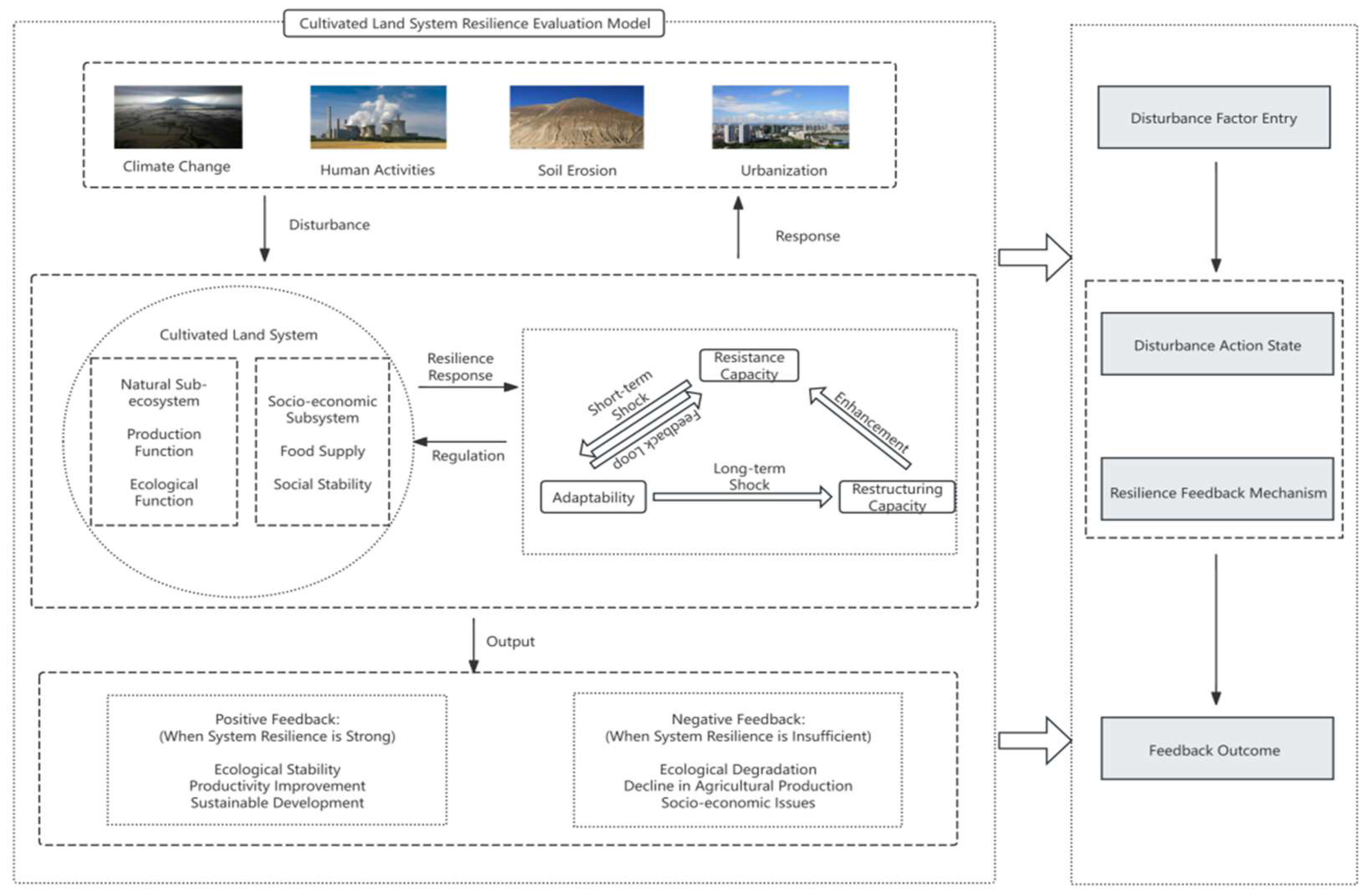
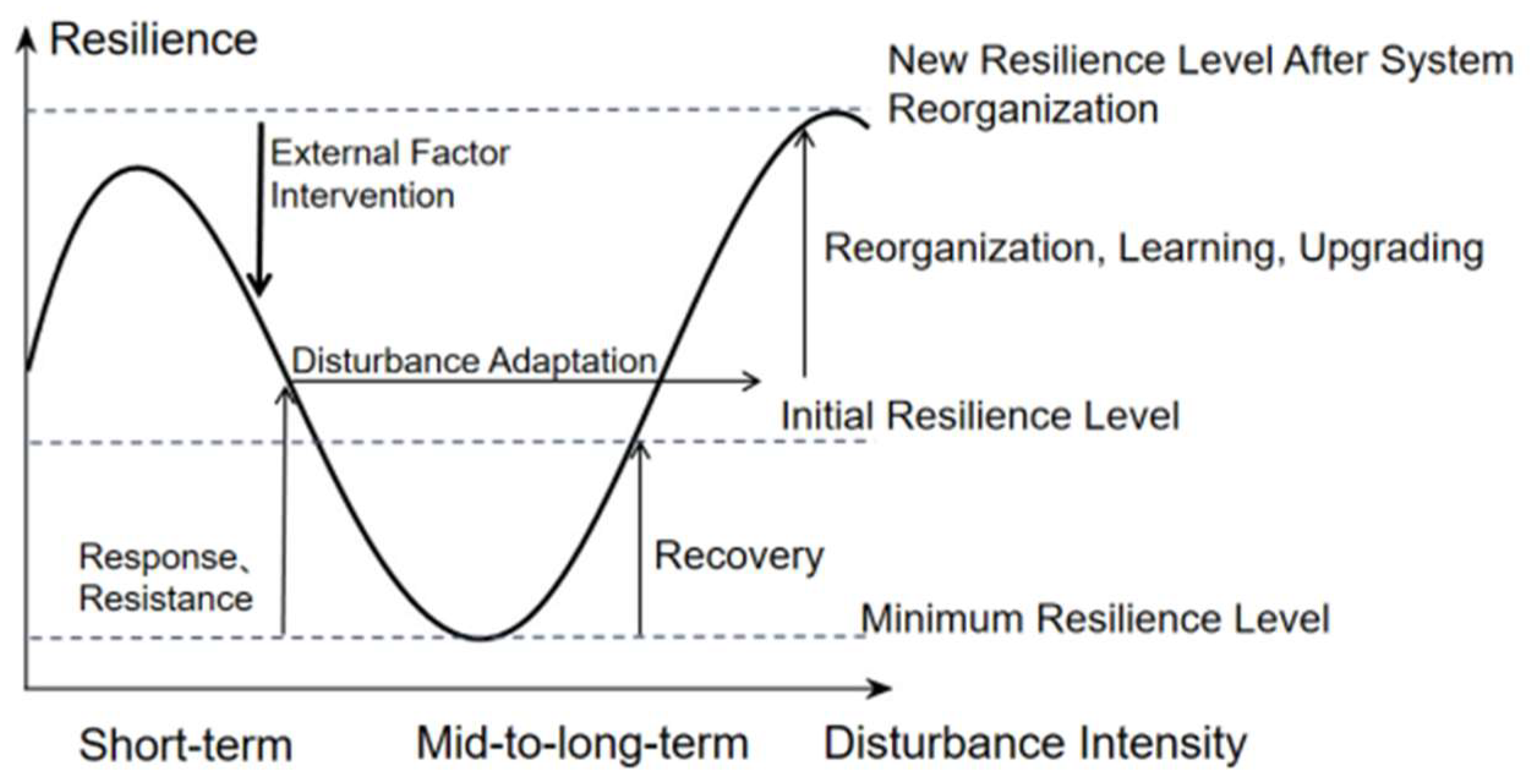


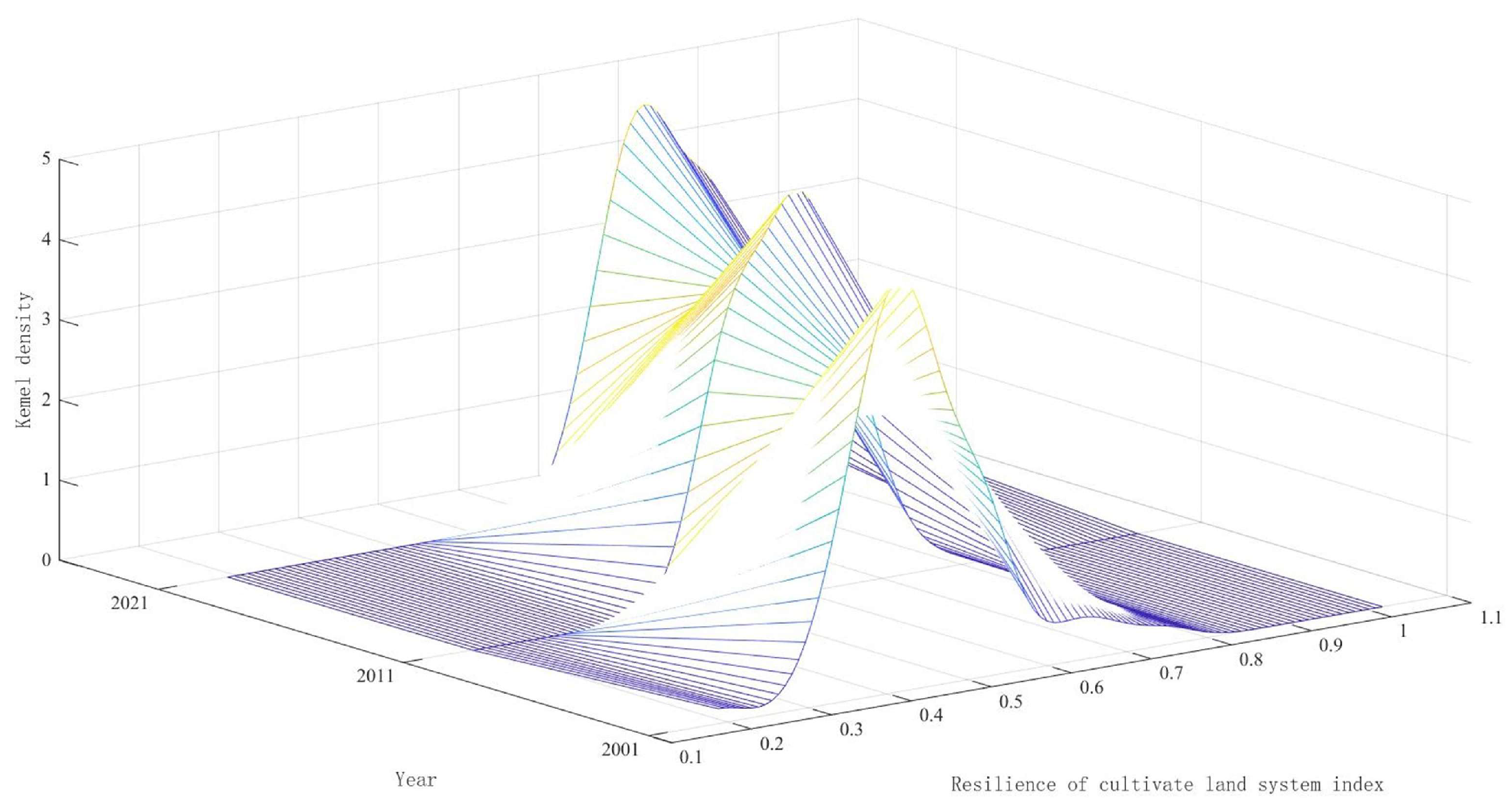

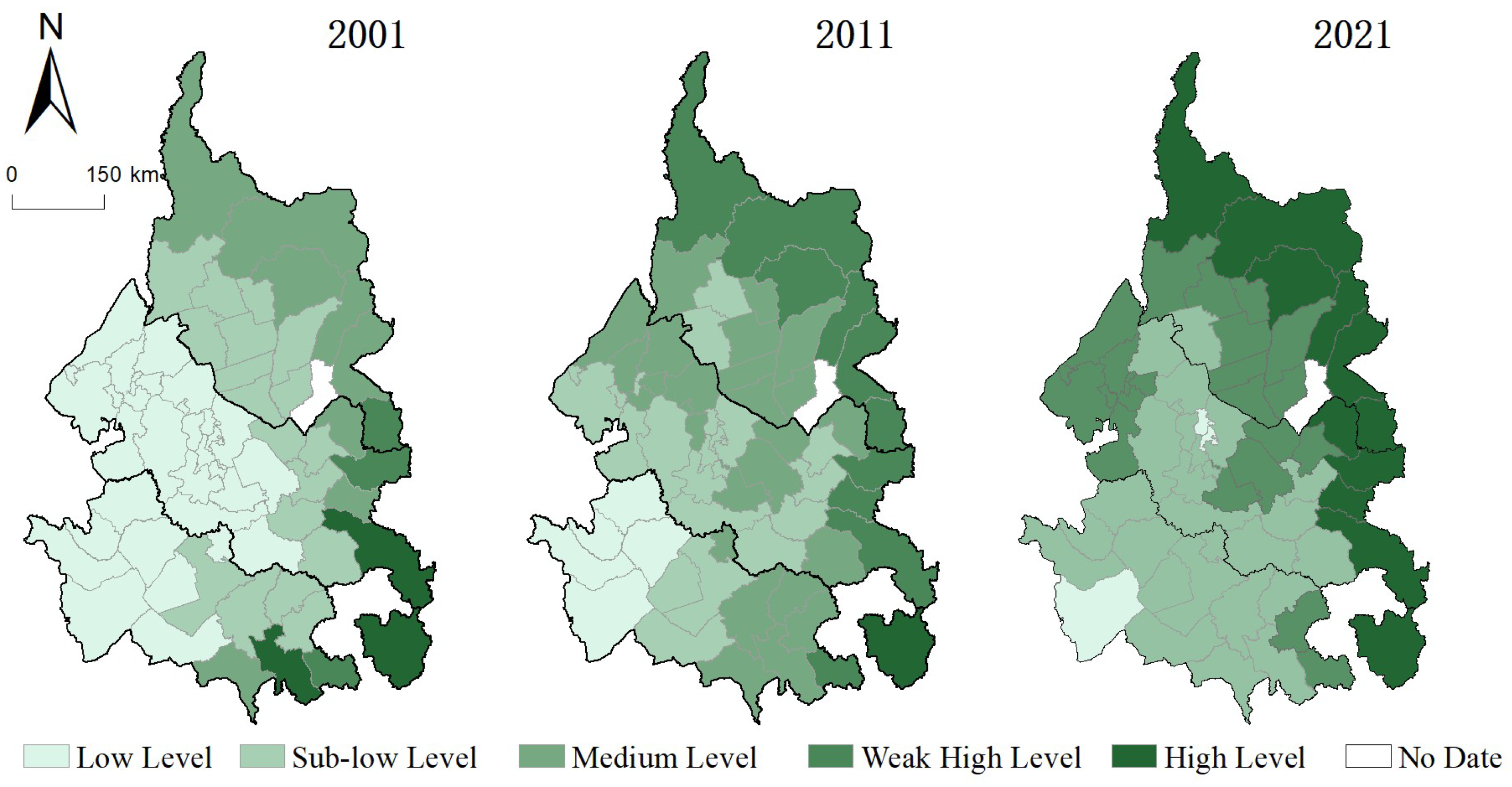
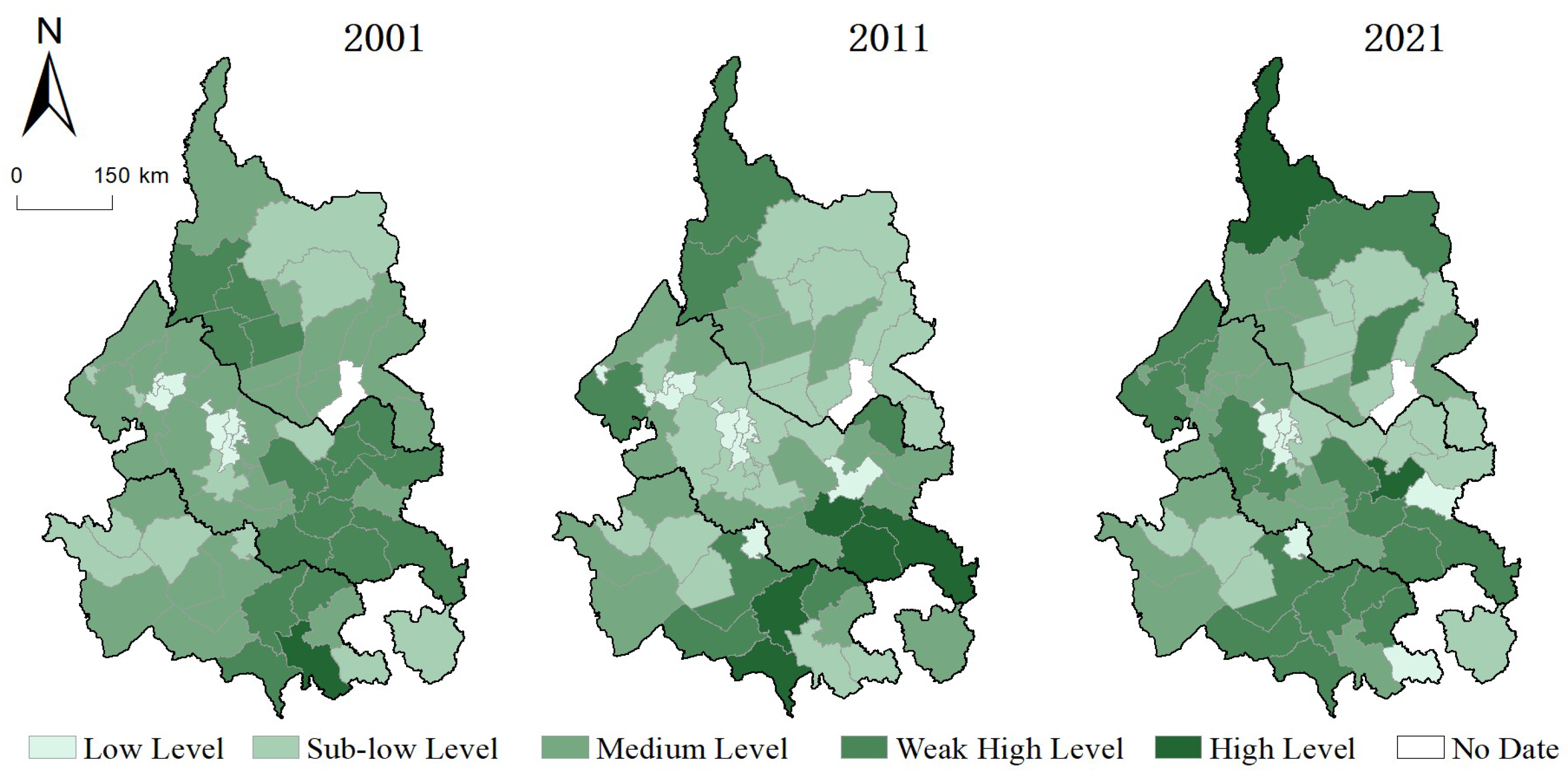
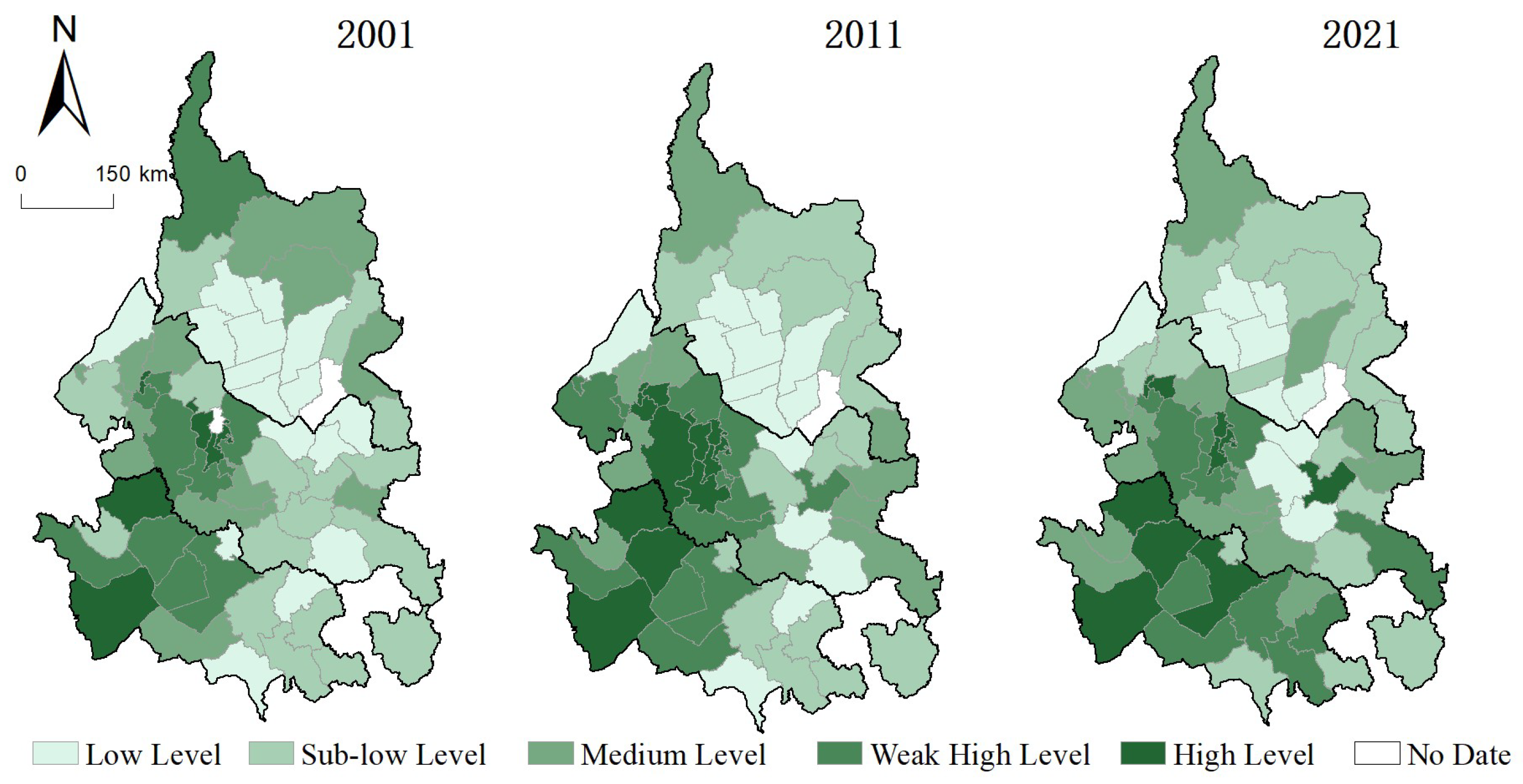
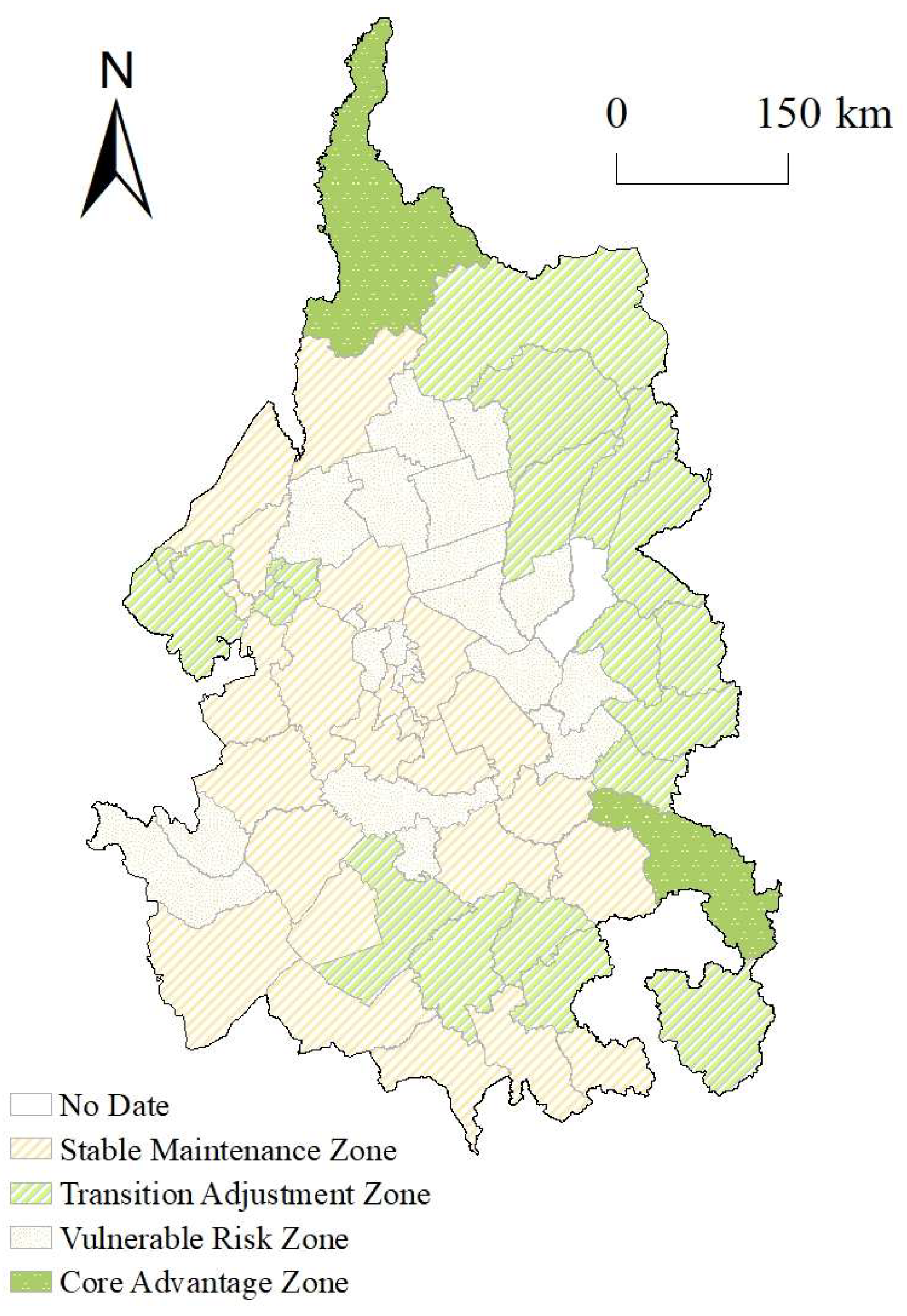
| Data | Type | Source |
|---|---|---|
| Land Use Data | Raster Data | Data Center for Resources and Environmental Sciences, Chinese Academy of Sciences |
| NPP | Raster Data | MOD17A3HGF.006 Data |
| DEM | Raster Data | ASTER GDEM Digital Elevation Model |
| Meteorological Data | Raster Data | National Earth System Science Data Center |
| Administrative Boundaries | Vector Data | Data Center for Resources and Environmental Sciences, Chinese Academy of Sciences |
| Socio-economic Data | Statistical Data | Statistical Yearbooks of Various Provinces and Cities |
| Criteria Layer | Indicator | Indicator Definition | Attribute | Weight | |
|---|---|---|---|---|---|
| Primary Level | Secondary Level | ||||
| Resistance | Cultivated Land Production Sustainability | Cultivated Land Area Change Rate | (Calculated as cultivated land area in the previous year/current cultivated land area/spatial unit) × 100; higher values indicate greater land fluctuation, negatively affecting system stability and resilience | − | 0.0166 |
| Multiple Cropping Index | Measurement of land use efficiency; reflects the degree to which cultivated land in the study area is effectively used within a year, calculated as follows: Total Sown Area/Total Cultivated Land Area × 100% | + | 0.1597 | ||
| Net Primary Productivity | Indicates productivity fluctuation; higher NPP reflects stronger ecosystem function and agricultural potential | + | 0.2774 | ||
| Climate Conditions | Annual Precipitation | Considers the impact of natural baseline factors on the resistance of cultivated land | + | 0.3522 | |
| Sunshine Hours | Indicates solar radiation intensity; more sunlight supports photosynthesis and longer growing periods, enhancing productivity and climate adaptability | + | 0.1941 | ||
| Adaptability | Socio-Economic Conditions | Primary Industry Output Value | Measurement of social state changes; reflects the economic benefits of cultivated land | + | 0.5125 |
| Proportion of Rural Population | Higher proportion of rural population; cultivated land with a higher rural population proportion has a stronger response to various changes | + | 0.1700 | ||
| Patch Cohesion Index | Higher cohesion index; indicates a stronger ability to adapt to disturbances | + | 0.0272 | ||
| Per Capita Cultivated Land Area | More cultivated land per capita indicates lower land pressure and better resource availability, supporting sustainable management | + | 0.2903 | ||
| Reconstruction | Agricultural Management Capacity | Total Agricultural Machinery Power | The level of agricultural machinery reflects the agricultural technological level within the region | + | 0.3207 |
| Amount of Fertilizer Applied | The capacity to respond to cultivated land that has been subjected to human disturbances exceeding a threshold | − | 0.0382 | ||
| Ecological Restoration Capacity | Fractional Vegetation Cover | Reflects the ecological condition of cultivated land; higher coverage indicates better ecological restoration, soil, and water conservation and stronger risk resistance | + | 0.0545 | |
| Landscape Evenness | Higher landscape evenness indicates a more uniform distribution of landscape types, which enhances the cultivated land system’s ability to reconstruct itself | + | 0.1668 | ||
| Patch Density | Greater patch density suggests a stronger ability to learn and reconstruct in response to external disturbances | + | 0.4197 | ||
| Entropy Value | Entropy Weight | ||||
|---|---|---|---|---|---|
| e1 | e2 | e3 | W1 | W2 | W3 |
| 0.9999 | 0.9998 | 0.9997 | 0.1667 | 0.3333 | 0.5 |
| Type | Quantity | Characteristics |
|---|---|---|
| Core Advantage Zones | 2 | High agricultural productivity, ecological stability, diversified economy, and strong risk resilience. |
| Stable Maintenance Zones | 23 | Moderate production and ecological recovery capacity, and agriculture dependence, with limited pressure resistance. |
| Transition Adjustment Zones | 20 | Traditional production methods, strong resource dependence, and weaker adaptability. |
| Vulnerable Risk Zones | 18 | Low productivity, ecological fragility, economic monoculture, and high susceptibility to external shocks. |
Disclaimer/Publisher’s Note: The statements, opinions and data contained in all publications are solely those of the individual author(s) and contributor(s) and not of MDPI and/or the editor(s). MDPI and/or the editor(s) disclaim responsibility for any injury to people or property resulting from any ideas, methods, instructions or products referred to in the content. |
© 2025 by the authors. Licensee MDPI, Basel, Switzerland. This article is an open access article distributed under the terms and conditions of the Creative Commons Attribution (CC BY) license (https://creativecommons.org/licenses/by/4.0/).
Share and Cite
Hang, Y.; Lu, X.; Li, X. Spatiotemporal Differentiation Characteristics and Zoning of Cultivated Land System Resilience in the Songnen Plain. Sustainability 2025, 17, 4314. https://doi.org/10.3390/su17104314
Hang Y, Lu X, Li X. Spatiotemporal Differentiation Characteristics and Zoning of Cultivated Land System Resilience in the Songnen Plain. Sustainability. 2025; 17(10):4314. https://doi.org/10.3390/su17104314
Chicago/Turabian StyleHang, Yanhong, Xue Lu, and Xiaoming Li. 2025. "Spatiotemporal Differentiation Characteristics and Zoning of Cultivated Land System Resilience in the Songnen Plain" Sustainability 17, no. 10: 4314. https://doi.org/10.3390/su17104314
APA StyleHang, Y., Lu, X., & Li, X. (2025). Spatiotemporal Differentiation Characteristics and Zoning of Cultivated Land System Resilience in the Songnen Plain. Sustainability, 17(10), 4314. https://doi.org/10.3390/su17104314





